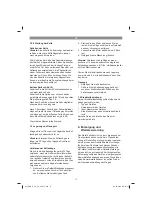
GB
- 24 -
5. Before starting the equipment
Danger:
Do not start the engine until the saw is
fully assembled.
Caution:
Wear protective gloves at all times when
handling the chain.
5.1 Fit the chain bar
To ensure that the bar and the chain are supplied
with oil, USE ONLY THE ORIGINAL BAR. The oi-
ling hole (Fig. 2/Item A) must be kept clear of dirt
and any build-up of residue.
1. Make sure the Chain brake lever is pulled
back into the DISENGAGED position (Fig.
3A)
2. Remove the bar fastening wheel (20). Remo-
ve the cover (Fig. 3B).
3. Turn the chain tensioning wheel (19) IN
COUNTER-CLOCKWISE DIRECTION until
the HINGE (E) (projecting tip) is at the end of
its sliding path in the direction of the coupling
roller and gear wheel (Fig. 3B/3C).
4. Fit the open end of the chain bar over the bar
pins (F). Align the bar such that the HINGE
fi
ts into the hole (G) in the chain bar (Fig.
3C/3D).
5.2 To install saw chain
1. Spread chain out in a loop with cutting edges
(A) pointing CLOCKWISE around loop (Fig.
4A).
2. Slip the chain around the sprocket (B) behind
the clutch (C). Make sure the links
fi
t between
the sprocket teeth (Fig. 4B).
3. Guide the drive links into the groove (D) and
around the end of the bar (Fig. 4B).
NOTE:
The saw chain may droop slightly on the
lower part of bar. This is normal.
4. Pull the chain bar forward until the chain is
closely seated. Make sure that all the drive
links are in the groove of the bar.
5. Attach the coupling cover (Fig. 5) and turn
the bar fastening wheel (20) clockwise to
secure it. The chain is not allowed to slip o
ff
the guide bar when you do this. Tighten the
bar fastening wheel by hand and then follow
the instructions for adjusting the chain tension
as described in the section ADJUSTING THE
CHAIN TENSION.
5.3. Adjusting the chain tension
The correct tension of the saw chain is extremely
important and must be checked before starting
and during all sawing work. If you take time to
adjust the saw chain correctly, you will be able to
make better cuts and the life of the chain will be
prolonged.
Caution:
Wear high-strength gloves
at all times when handling or adjusting the saw
chain.
1. Hold the tip of the chain bar upwards and turn
the chain tensioning wheel (19) IN CLOCK-
WISE DIRECTION in order to increase the
chain tension (Fig. 5). If you turn the chain
tensioning wheel IN COUNTER-CLOCKWI-
SE DIRECTION, the chain tension will be re-
duced. Check that the chain is seated around
the entire chain bar (Fig. 6).
2. After making the adjustment and with the tip
of the bar still upwards, tighten the bar faste-
ning wheel (20). The chain is correctly tension
when it is closely seated and can be pulled
right around by hand.
Note:
If the chain is hard to turn around the chain
bar or blocked, it is too tightly tensioned. Make
the following small adjustments:
1. Undo the bar fastening wheel (20) by 1/2 re-
volution. Slacken the chain tension by slowly
turning the chain tensioning wheel (19) IN
COUNTER-CLOCKWISE DIRECTION. Pull
the chain back and forth on the bar. Do this
until the chain can be moved smoothly but
is still closely seated. Increase the tension
by turning the chain tensioning wheel IN
CLOCKWISE DIRECTION.
2. When the saw chain is correctly tensioned,
hold the tip of the bar upwards and tighten the
bar fastening wheel (20).
Note:
A new saw chain stretches, requiring ad-
justment after as few as 5 cuts. This is normal
with a new chain, and the interval between future
adjustments will lengthen quickly.
Note:
If the saw chain is TOO LOOSE or TOO
TAUT, the drive wheel, chain bar, chain and crank
shaft bearing will su
ff
er premature wear. Fig. 6
shows the correct tension A (when cold) and ten-
sion B (when warm). Fig. C shows a chain that is
too loose.
Anl_GMS_E_40_EV_SPK7-1.indb 24
Anl_GMS_E_40_EV_SPK7-1.indb 24
02.07.2019 06:33:15
02.07.2019 06:33:15
















































